Comparing historic photos of glaciers to modern images provides a springboard for scientists to measure the effects of climate change in Denali.
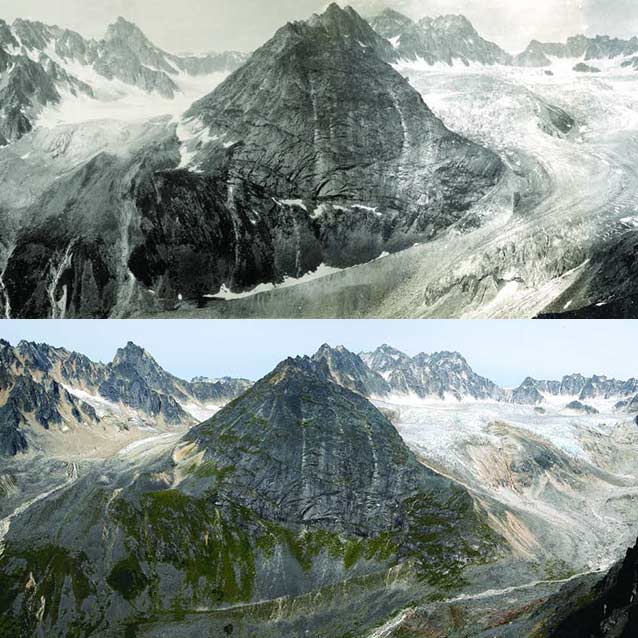
Top: S.R. Capps, USGS. Bottom: NPS Photo
Introduction
Climate and topogra-phy are the primary driv-ers of glacial systems, and glaciers record the trends for all to observe. The climate is constantly changing, and glaciers have responded through time, with evidence of advance and retreat cycles recorded in the geologic record. The growing evidence of unprecedented warming rates and wide ranging effects is well document-ed, recently in the com-prehensive and international Arctic Climate Impact Assessment (2005). There are substantial and far reaching impacts of a warming climate, but few are as dramatic and visible to national park visitors as changes to glacial systems.
Glaciers are a significant geologic feature of Denali National Park and Preserve, cur-rently covering approximately 17 percent or 1,563 square miles (4,047 km2) of the park. Highly sensitive to changes in temperature and precipitation, glaciers dynamically react to climatic drivers by thickening and advancing during periods of increased accumulation, and thinning and retreating during periods of increased ablation. Alteration of the Denali cryosphere directly influences the physical landscape, the local hydrologic regime, and the diversity and spatial distribution of biologic com-munities in the park. Understanding the scale and pace of past glacial system changes in Denali provides critical insight into how these processes may continue in the future.
Glacier monitoring in Denali has taken various forms since the early 1900s, with early explorers, visitors, and managers documenting the landscape through pho-tography or descriptive field notes, to more recent mass balance monitoring and detailed measurement of change in glacial extent through formal surveys and satellite imagery. The composite data presented herein characterize the ongoing change in Denali and tell a compelling story of glacial retreat, dramatically illustrated through comparative photography and supported by detailed measurements.
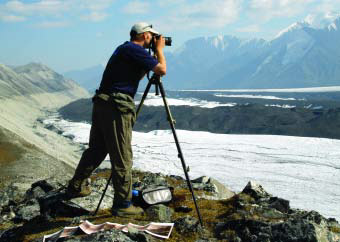
NPS Photo
Worth a Thousand Words
Like many of today’s visitors, early explorers, visitors, and managers approached Denali with an appreciation for natural systems. Their excitement for the new-found places enticed them to record what they saw to share with the rest of the world, whom they (as we) might often feel, were not as fortunate to view firsthand. Our studies of glacial change in Denali have benefited tremendously from the careful records of early visitors. We are able to visually identify 50-80 years of glacial change across the park through comparative photography.
Data gathering and research involved locating and digitizing historical photographs (taken circa 1906- 1950) from the USGS Photo Archive in Denver, Colorado, the Denali National Park and Preserve archive, and the University of Alaska at Fairbanks archives and library. Photo quality ranged from highly degraded black and white and sepia ‘snapshot’ size photographs to professional quality 8"x10" photo nega-tives taken by Bradford Washburn. Significant contribu-tions came from the collections of Cathcart, Reed, Washburn, and Capps. We are continually in pursuit of early photographs documenting glaciation in Denali—building a comprehensive record of change.
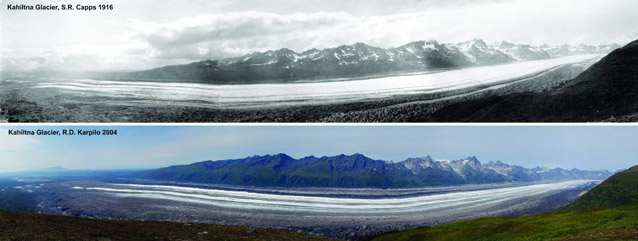
Top: USGS Photo; Bottom: NPS Photo
Modern photographs, repeating historical photographs as accurately as possible, were taken in both digital and negative film formats. A Nikon D100 digital SLR camera and a Nikon F100 film camera with Fuji Velvia and Provia films with a variety of lenses were used for this study. We hiked to the photograph sites to minimize potential impacts and con-flicts whenever possible, using motor-ized access only where necessary.
Data suggest that the majority of the glaciers included in this study have gen-erally retreated, thinned, or stagnated over the observed time periods. The most notable change has been on glaciers with accumulation zones below 8,200 ft (2,500 m). On the East Fork Teklanika Glacier there has been nearly ~980 ft (300 m) of obvious thinning and associated retreat. In addition to observed changes on the larger glaciers, small, “pocket” glaciers have undergone significant thinning and retreat. There has been surge activity in the past century, but no glaciers show signs of thickening or advance.
Photos demonstrate the considerable perspective that can be gained from studying historical photographs. General changes in glacier thickness, terminus extent, ice dynamics, and ele-vational variations can be interpreted. Inferences of ecological changes and impacts to the dependent hydrologic regime are logical applications of the data.
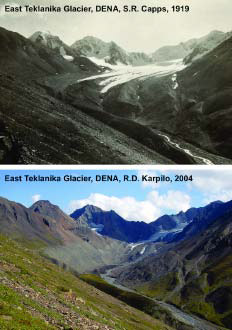
Top: USGS Photo; Bottom: NPS Photo
Ground Truthing Change
While comparative photography provides extensive data that tell a powerful story, it lacks quantitative rigor that is often preferred when developing scientific conclusions. In order to accurately measure the change, park personnel regularly survey glacier terminus positions of the more accessible glaciers. Earlier surveys used traditional theodolite surveying techniques while map-grade GPS measurements are now the standard. Measurements indicate retreat on all measured glaciers, with averages near 66 ft (20 m) per year. Figure 7 is an example of the results on the Middle Fork Toklat Glacier. GPS survey results are compared to aerial photography and satellite images to document the change in the terminus position.
Measuring the positions of the termini in the Alaska Range is complicated by the geology of the park. Many of the best known coastal Alaska glaciers occur on geology dominated by fairly durable meta-morphic and igneous rocks. In contrast, while the Denali massif has a granite core, many of the glaciers occur in highly friable marine sedimentary rocks. These rocks quickly break down and form large medial and lateral moraines which often disperse to veil the glacier termini, providing insulation which slows retreat. While glacial extent is an important part of the glacial system, volume change measure-ments provide a more robust estimate of glacial health.
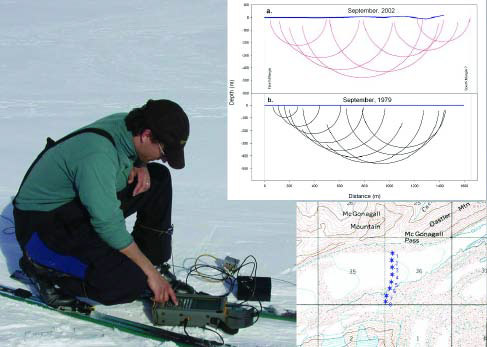
NPS Photo
Volume change calculations require significantly more data and a spatial analysis of glaciers. Arendt et al. (2002) methodically estimated volume change of Alaska glaciers using laser altimetry measurements taken from a low flying plane. Measurements suggested that many of Denali’s glaciers were losing up to 6.6 ft (2 m) of vertical water equivalency per year. They showed that the widespread loss of the volume in Alaska glaciers contributes substantially to sea level rise. Detailed ongoing work on volume loss will help discriminate elevational variations in volume change. Park scientists are currently using LIDAR (laser altimetry of entire surfaces) to calculate volume change on the Muldrow Glacier. Another method used to quantify glacier change is through radar depth measurements, repeated in the same location over a time interval. Shown in Figure 9, the Muldrow Glacier is observed to thin by approximately 66 ft (20 m) between 1979 and 2004.
Mass balance trends also provide important insight to the behavior of glacial systems. Mass balance index sites, describ-ed by Mayo (2001) and Adema (in press), provide single point quantified trends of glacier dynamics. Figure 10 shows the character of the Traleika index site near the 6,890 ft (2,100 m) elevation level. Measurements at this site are made at the end of the accumulation season (May) and the end of the ablation season (September). At this site, the Traleika glacier is observed to be thickening (increasing surface elevation) while having a negative mass balance. This might be explained through a process of the Traleika Glacier “building up”, or “inflating.” New ice is added to the glacier from higher tributaries and accumulation areas, while outflow is impeded by the downstream Muldrow and Brooks glaciers, causing a compressive flow regime. Concurrently, the glacier surface is experiencing more summer melting than winter accumulation (negative balance). The thickening caused by the compressive flow is greater than the negative surface mass balance, where more ice is melting than is accumulated each year. This phenomenon may contribute to the surge behavior of the Muldrow Glacier.
The Constant is Change
Glacial systems are inherently dynamic, defined by topography, accumulation rates, ice dynamics, and ablation rates. The warming climate’s effect on glaciers is well documented through the recreation of historic photos, field measurements, and interpretation of remotely sensed imagery. Glaciers are a key component of the hydrologic system, and as the glacial volumes and discharge change, so too will stream dynamics and sedimentation characteristics. The ecosystems will slowly evolve in reaction to the environmental changes ultimately caused by climatic forces. The rates of change documented are significant, and if the trends continue, the next generation will visit a very different Denali National Park and Preserve. Continued monitoring will provide objective documentation of our changing environment for future generations to better understand the complex ecosystem dynamics. Understanding the scale and pace of past glacial system changes in Denali provides critical insight into how these processes may continue in the future.
It is clear from this work that the glaciers of the central Alaska Range are thinning and retreating rapidly. More work is needed to model the interrelationships of climate change and glacier fluctuations, but it appears that if current climatic trends continue, the glaciers of Denali National Park and Preserve will experience continued retreat.
Acknowledgements
This work was made possible by the NPS Fee Demonstration program and the Central Alaska Inventory and Monitoring Network. Larry Mayo, Keith Echelmeyer, Phil Brease, Jamie Rousch, Chad Hults, Pamela Sousanes, and Adam Bucki played critical roles in the success of the glacier monitoring program.
References
Arctic Climate Impact Assessment (ACIA). 2005. Cambridge University Press. Adema, Guy W. (in press). Glacier Monitoring in Denali. Proceedings of the 2006 Alaska Park Science Symposium. Alaska Park Science. Arendt, Anthony A., Keith A. Echelmeyer, William D. Harrison, Craig S. Lingle, Virginia B. Valentine. 2002. Rapid wastage of Alaska glaciers and their contribution to rising sea level. Science 297:382-386. Mayo, Larry. 2001. Manual for Monitoring Glacier Responses to Climate at Denali National Park, Alaska, Using the Index Site Method. Denali National Park technical report.
Last updated: January 12, 2015
